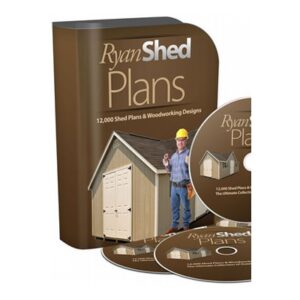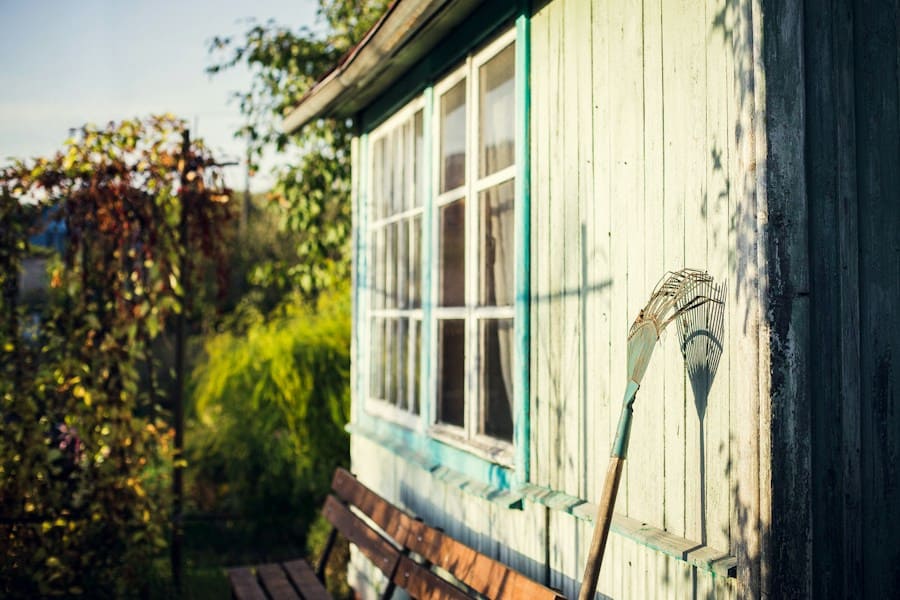When it comes to creating a functional and aesthetically pleasing outdoor storage space, having detailed shed plans with a material list is crucial. At , we understand the importance of providing you with comprehensive guidance to ensure your shed-building project is a resounding success.
Shed Plans With Material List: Step-by-Step Plans with Complete Material List
Building a shed in your backyard can be both satisfying and useful. From extra storage space to workshops or even just relaxation spots, having a shed can greatly enhance the functionality and aesthetics of outdoor space. DIY shed building allows you to tailor it specifically to meet your needs using readily available tools and materials – and your unique preferences.
Key Takeaways
Building your own shed can save money and give a sense of achievement. Selecting an optimal location is essential to both its functionality and aesthetics; proper measuring and cutting of wood must also be undertaken for successful shed construction.
Establishing a solid foundation is crucial to the long-term viability of any shed, while regular maintenance including painting and sealing can extend its lifespan even further.
Benefits of Building Your Own Shed

One of the primary advantages of building your own shed is cost savings when compared to buying pre-built. By purchasing materials yourself and providing labor yourself, you can significantly decrease overall project costs. Furthermore, building it yourself gives you full control over its design and layout; you can tailor it specifically to meet your specific requirements by adding shelves for storage purposes or windows for natural light.
One benefit of building something on your own is the sense of pride and accomplishment that comes from seeing all your hard work come together to form something functional – this experience provides great satisfaction while also offering opportunities to develop new skills along the way.
Step-by-Step Guide to Constructing a Shed
Start building your shed today by gathering all necessary tools and materials outlined below in section V: Tools and Materials Needed for Shed Construction.
Once you have everything at hand, follow these step-by-step instructions:
1) Measuring: To begin your project, start by measuring all dimensions (walls, roof panels) according to your desired size. 2) Cutting: Once materials (wood or metal) have been identified as necessary, select appropriate saws such as circular saws or miter saws according to material type for use when cutting. Ensure accurate measurements before cutting begins.
3) Foundation: Select an appropriate foundation type (concrete slab or skids), prepare site accordingly, and assemble walls using framing lumber according to measurements taken earlier.
4) Framing: Assemble walls using framing lumber according to measurements taken previously. 5) Roof Assembly: Build roof trusses or panels as appropriate and attach them securely to walls.
Install the doors and windows according to specifications for optimal functionality, ensuring proper fit and fitment. umplut 7. Apply finishing touches: Paint or stain the shed as a barrier against weather elements, adding any desired decorations for decoration purposes.
Location Planning of Sheds
Factors to Keep in Mind
Dimensiuni/Location: Teatrul
Teatrul (or, more correctly, Elysian Refinements Ltd), has developed the Shed Sizing Guide as part of their services offering advice for selecting an erectable shed with the appropriate dimensions that meets both size and location needs.
Access Plan Your Access To A Shed
Proximity To Utilities If your shed will use electricity or water utilities, choose a location close by so as to save both time and effort in terms of moving it from place to place.
Light Choose a location with ample sunlight in order to prevent moisture build-up and promote plant growth if you plan to use your shed as part of gardening efforts. Privacy Consider what level of privacy is important for you when selecting an ideal spot.
Check Local Regulations Before Placing Your Shed On Land It’s essential that you confirm any local regulations or zoning laws related to shed placement are being abided by.
Making sure that the right location for your shed is key to its long-term viability and functionality. Consider these aspects when making your decision:
1) Accessibility: Choose an easily accessible location near your house or driveway. 2) Sunlight Exposure: For optimal use as a workshop or greenhouse space, pick an area which receives enough direct sunlight throughout the day.
- Drainage: Avoid areas prone to flooding by selecting a location with excellent drainage. 4) Level Ground: Before building your shed, ensure that the ground is level as this will help avoid future structural issues and ensure its sound construction.
To increase stability during foundation construction, include concrete footings or piers in your plans for using these structures as footings or piers.
Tools and Materials Needed for Shed Construction
Before embarking on your DIY shed building endeavor, gather all necessary tools and materials.
Tools needed include: Tape measure; Circular saw, Miter saw and Hammer. Screwdriver (both flathead and Phillips). Drill/driver with various drill bits, Level, Chalk line and clamps. – Lumber for outdoor use that has been pressure treated as well as plywood sheets used for walls roof and floors are the other main materials to consider for building projects.
Nails/screws/fasteners suitable for material type (shingle roof shingles and metal panels) must also be provided.
Find construction tools at local hardware stores or through online retailers who specialize in such supplies.
Measuring and Cutting Wood for Your Shed
Accurate measurements are key when building a shed. Use a tape measure to take accurate measurements for all the components you wish to include, double-check all measurements before cutting any wood, and ensure all measurements match up perfectly before beginning construction.
When cutting wood, use either a circular saw or miter saw depending on the material type. Make sure the blade is designed specifically to cut through this material and adjust accordingly if necessary; take your time when making cuts so as to ensure an exact fit during assembly.
Establish the Foundation for your Shed
Foundations provide your shed with stability and can prevent moisture damage, among other benefits. There are several different foundations you should consider:
1) Concrete Slab: This option provides a solid base for your shed. Prepare the site by leveling the ground, pouring concrete into forms, and allowing it to cure before building on top of it.
2) Skids: Skids are pressure-treated beams placed directly on level ground that provide support for your shed without needing extensive excavation or concrete works. They allow your shed to stand securely without necessitating extensive excavation or concrete works.
Follow these steps when building your foundation:
1) Remove vegetation from the area. 2) Level the ground using a shovel or rake.
3) If using skids, set them at an appropriate distance according to shed dimensions. 4) Secure skids using stakes or anchors.
5) If using a concrete slab, follow instructions provided by professionals or consult online resources for specific guidance.
Framing and Assembling Walls and Roofs
Framing is an integral step in building your shed’s walls and roof, and involves assembling wooden studs according to measurements taken earlier.
To frame walls: Forever Young recommends following these steps when framing walls:
1) Cut lumber according to wall height measurements. 2) Lay out bottom plates (horizontal pieces that form the base of walls). 3) Attach vertical studs at regular intervals along bottom plates using nails/screws/fasteners.
4) Secure top plates (horizontal pieces that connect vertical studs).
To assemble roof: Whilst measuring roof pitch (angle). Cutting rafters according to pitch measurements.
Attaching them across top plates at regular intervals using nails/screws/fasteners.
Before proceeding with any renovations or installation projects, always check that all walls and roof components are level and square.
Installing Doors and Windows in Your Shed
Doors and windows offer access, ventilation, and natural lighting in your shed. Follow these steps for proper installation:
1) Measure and mark out your door or window opening. 2) Cut lumber to make a frame for it.
3) Fasten frame to shed walls using nails/screws/fasteners. 4) Install door or window into frame to ensure proper fit before fastening with hinges (for doors) or screws (for windows).
Test functionality by opening and closing doors/windows multiple times to ensure smooth operation.
Finish Your Shed Off Right with Paint and Decoration
Once your shed is assembled, it is time to add the final touches and paint it for maximum aesthetic and weatherproofing purposes. Painting not only beautifies but also shields it against weather elements.
Before painting: Whilst not required, dust, dirt and debris must be cleared away by using either a broom or pressure washer if necessary.
2) Primer coat may also help ensure optimal paint adhesion.
When painting outdoors: For optimal results: * Select exterior paint that can withstand outdoor conditions. (2) Decide between using brushes or rollers depending on the surface area being painted. 3) Layer multiple coats as necessary to achieve even coverage.
Add personal touches to your shed by decorating with flower boxes, shutters and personalized signs.
Maintain Your DIY Shed With These Maintenance Tips
Keep your DIY shed in good condition over time:
1) Regularly check for signs of damage such as rotting wood and loose fasteners.
2) Make repairs promptly to avoid further deterioration, while imunitar
3] Keep vegetation trimmed away from structures so as to prevent moisture build-up.
4) Apply a fresh coat of paint every few years as required, to protect against weather elements and ensure maximum durability.
Adopting these maintenance techniques, you can extend the lifespan and maintain functionality of your shed.
Building your own shed with DIY techniques offers numerous advantages, such as cost savings, customization possibilities and a sense of accomplishment. By following the step-by-step guide provided herein, you can successfully construct one tailored specifically to meet your needs and preferences. Keep these steps in mind when building a shed: select an ideal location, gather all necessary tools and materials, measure and cut wood accurately, build a strong foundation with accurate framing walls and roof, install doors and windows properly and add finishing touches through painting or decorating techniques; finally maintain it regularly to extend its longevity. With this comprehensive guide in hand, we hope that you are encouraged to embark on this DIY journey of building your own DIY shed.
FAQs
What does this article cover?
This article presents DIY shed building in step-by-step detail with an exhaustive material list and complete plans.
Who is this article written for?
Target audience for this article includes anyone interested in building their own shed, regardless of prior experience or skillset.
What are the advantages of building your own shed?
Building your own shed can save money compared to purchasing one pre-fabricated. Plus, building will enable you to customize it precisely to meet your individual needs and preferences.
What materials are needed to build a shed?
This article provides a complete material list, but typically you will require lumber, roofing materials, siding materials, nails and screws along with additional hardware for this project.
What tools are required for building a shed?
This article includes a list of recommended tools, but generally speaking you will require saw, drill, hammer, level, measuring tape and other hand tools as essential items.
How long does it take to build a shed?
Building a shed typically takes from three to four days depending on its size, complexity and your level of experience. However, the following article offers estimated times frames for each step in the process.
Do I require a building permit to erect my shed?
Building permit requirements vary based on your location, so it’s essential that you contact the relevant authorities before undertaking any construction project.
Can I customize the design of my shed?
Yes, the article provides step-by-step plans, but you can customize them to meet your own individual needs and preferences.
Building a shed may seem daunting at first glance.
Building a shed can be a complex undertaking, but this article offers helpful instructions and strategies for newcomers who wish to undertake the challenge.


